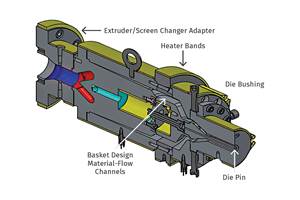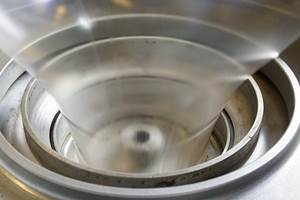Novel Extruder Takes Unique Approach to Feeding, Melting
MixFlow extruder relies on conductive heating to melt plastics, upending conventional wisdom on how plastics melt inside conventional screw extruders.
A young Canadian company has developed and patented a novel type of extruder that it says upends long-held beliefs about how plastics melt in such machines.
Called MixFlow and patented by of Toronto, Ontario, the extruder was originally designed to produce monofilament for additive manufacturing. ReDeTec currently has several such machines in the market.
Recalls Dennon Oosterman, ReDeTec CEO, “Myself and my co-founders at the time were all engineering physicists at UBC University of British Columbia in Canada. And we’d gotten 3D printers in the lab long before anyone knew what they were. And, basically, with a class of 50 engineers, we were churning through prototypes that were getting thrown out. We were making a lot of waste.
“So, we decided to engineer a system that would recycle waste back into 3D printer filaments. That’s what ReDeTec sells and does today. At the time, we knew nothing about extrusion processing or the plastics industry. We wanted to develop a simple desktop machine where a student in class could walk up, push a button, produce some filament an hour later, then shut it down until it’s ready to be used by someone else.”
ReDeTec began to look at new applications before COVID-19. Oosterman elaborates: “We started looking more seriously into whether we could scale this technology so that instead of it just being on a desktop for 3D printing, could it be used in factories that are extruding or injection molding tons of plastic every hour? We did an initial study to see if the technology would scale up at all. That went relatively well. Then, from a 大象传媒 development standpoint, we researched whether plastics manufacturers were having issues, for example, with reprocessing recycled material or with the energy efficiency of their existing machines.”
Once the pandemic ended, ReDeTec raised additional funding from investors and hired more engineers. Shortly thereafter, it produced its pilot production prototype. “We found our machines did better in certain areas compared to industry standards,” Oosterman says. “One is energy efficiency. We’re at around 84% efficient right now and hope to get into the 90s, which as far as we can tell is quite good. We also believe our system works better in reprocessing recycled plastics. With our technology, we see less in the way of property degradation, so in theory with our machine a manufacturer could use more recycled plastics in a product without sacrificing output or quality. Our machine is also easier to operate.”
Machines in use now are operating at throughputs of “grams per hour, which is nothing,” Oosterman notes. He adds, “Our original machine did 200 grams an hour. We’re now at around 10 kilograms/hour (22 pounds) looking to hit 20 kilograms/hour (44 pounds).”
Oosterman says ReDeTec is looking to partner with established extruder and injection molding OEMs to take the technology to the next step.
How It Works
The ReDeTec MixFlow is a compact machine with an L/D ratio down to 6:1. Unlike traditional extruders, it separates the feeding and melting sections with a thermal insulator (see Figure 1), which prevents conductive heat transfer to the feeding section. In the feeding section, material is conveyed via a propeller/auger to the melt section. There, external heaters around the barrel and a melting insert melt the material. There is direct contact between the inner surface of the barrel and the outer surface of the melting insert, which the inventors say provides for a direct conductive heat transfer path. Unmelted material from the feeding section provides the pressure necessary to push the polymer in the melt section to the die.
FIG 1 Comparison of a typical extruder to MixFlow. Note the thermal insulator separating the solids feeding and melting sections. Images: ReDeTec
The concept runs counter to a long-established standard that using conductive heating to melt plastics is inefficient because of their low thermal conductivity. Oosterman does not dispute this.
“What it really does differently is melt plastic without viscous shear.”
“It’s absolutely true, plastic is an insulator; it doesn't like to conduct heat,” he says. “The traditional way to get around that is to move the plastic to the heat at the outside of the barrel. What we do instead is move the heat to the plastic. We use some highly conductive material, usually aluminum or brass, that brings the heat inward to melt the plastic.”

FIG 2 Exploded view of MixFlow depicts separation of feeding and melting sections, separated by thermal insulator. No screws here; a feed auger conveys material to the melting section.
Oosterman continues, “In a typical extruder, the plastic is heated right at the outside of the barrel and then mixed around by the screw until it is finally uniformly brought to temperature. In MixFlow the plastic travels straight along and the heat is brought to it at the widest gap. The channels in our inserts are a few millimeters wide. As the plastic flows, it gets divided, recombined and split (by the melting insert) repeatedly through a heated core. What it really does differently is melt plastic without viscous shear.”
Oosterman says his system uses up to 50% less energy than conventional extruders, a fact some industry experts attribute to the fact that MixFlow units in operation are running a very low throughput.
But Oosterman compares melting plastic in a conventional extruder to a stove trying to boil water. “You’re only heating the bottom of the pot, so the temperature needs to be hotter than necessary to get all the water to boil. In an extruder, the plastic that’s sitting right on the edge of the screw flight as the screw ‘sweeps’ the barrel is getting heated more than it needs to. And this excess heat is then dispersed through the rest of the plastic.

FIG 3 MixFlow extruders have found a niche in 3D printing, but inventors at its developer ReDeTec are looking to scale up the technology to extend its applications.
In MixFlow, moreover, mixing of additives and colorants are carried out by the many little channels that make up the melting inserts. “We’ve spent a lot of time on designing different channel geometries,” Oosterman says. “We started with straight channels, and when we were trying to color PLA or ABS for filament, we’d get something that looked like it came out of a toothpaste tube: a little red here, a little green there and so forth. Now we have channel geometries that split and bring the streams together 10, 20 even 30 times. And we’re getting every dispersed quite evenly.
On the matter of pressure, Oosterman notes that MixFlow machines in place are currently running in the high hundreds, low thousands psi. “We know the industry standard is like 2,000-10,000 psi based on the complexity of the profile. That is our next challenge, and we are devoting quite a bit of engineering work in this area.”
Related Content
Shredding Thin Film: How to Do It Right
While many processors recoil at this task, a little know-how in shredding equipment, processing, and maintenance should add the necessary confidence.
Read MoreHow to Select the Right Tooling for Pipe Extrusion
In pipe extrusion, selecting or building a complementary set of tooling often poses challenges due to a range of qualitative factors. Here’s some guidance to help you out.
Read MoreWhy Are There No 'Universal' Screws for All Polymers?
There’s a simple answer: Because all plastics are not the same.
Read MoreReduce Downtime and Scrap in the Blown Film Industry
The blown film sector now benefits from a tailored solution developed by Chem-Trend to preserve integrity of the bubble.
Read MoreRead Next
Lead the Conversation, Change the Conversation
Coverage of single-use plastics can be both misleading and demoralizing. Here are 10 tips for changing the perception of the plastics industry at your company and in your community.
Read MoreMaking the Circular Economy a Reality
Driven by brand owner demands and new worldwide legislation, the entire supply chain is working toward the shift to circularity, with some evidence the circular economy has already begun.
Read MoreSee Recyclers Close the Loop on Trade Show Production Scrap at NPE2024
A collaboration between show organizer PLASTICS, recycler CPR and size reduction experts WEIMA and Conair recovered and recycled all production scrap at NPE2024.
Read More














